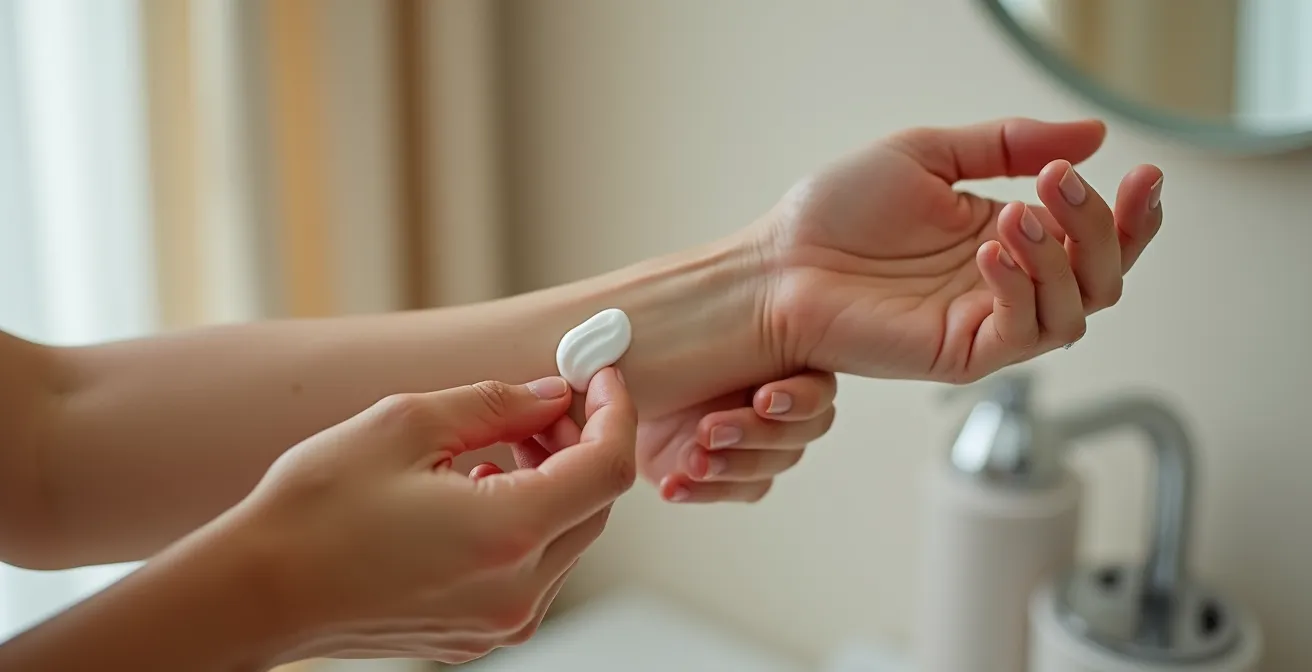Choosing a sunscreen often feels like a sensory experience, guided by appealing scents that evoke summer and vacation. Yet, this pleasant fragrance might be the very thing compromising your skin's health. The decision to opt for a truly fragrance-free formula goes far beyond simply avoiding a potential skin rash; it is a strategic choice for long-term skin integrity and effective sun protection.
The core issue lies in a fundamental conflict: sensory additives, designed for appeal, can actively work against the product's primary purpose. A well-formulated, high-protection sunscreen SPF50+ that is fragrance-free prioritizes efficacy and safety, recognizing that what you leave out is as important as what you put in. This article delves into why skipping the scent is one of the smartest decisions you can make for your skin and the environment.
Your Sunscreen's Scent: The Core Issues
- Systemic & Environmental Impact: Fragrance chemicals affect more than just skin, with potential respiratory effects and harm to aquatic ecosystems.
- The Phototoxicity Paradox: Certain scent ingredients can make your skin more sensitive to the sun, leading to burns and hyperpigmentation.
- Long-Term Cumulative Damage: Chronic, low-grade inflammation from fragrances can accelerate aging and disrupt your skin's natural defenses.
- Informed Consumer Choices: Learning to read ingredient labels is key to avoiding hidden irritants in products marketed as "natural" or "unscented."
How "fragrance" in sunscreen impacts more than just your skin
When we think of fragrance-related issues, we typically picture immediate skin irritation or allergic reactions. While contact allergy to fragrances is a significant concern that affects up to 2.6% of the general population in Europe, the effects of synthetic scents in a product worn all day can be far more systemic. Inhaling these volatile compounds can trigger headaches or respiratory discomfort in sensitive individuals.
Beyond personal health, there's a growing environmental concern. When you swim or shower, these fragrance chemicals wash off into our waterways. Many are not biodegradable and persist in the environment, contributing to water pollution. This issue echoes the broader 'reef-safe' conversation, where an estimated 6,000 to 14,000 metric tons of UV filtering chemicals are released annually into coastal regions, but it extends to all the additives in our personal care products.
Sunscreen chemicals are frequently detectable in tissues from marine mammals, seabirds, fishes, invertebrates, and aquatic vegetation, but the levels that cause toxicities are unknown for most of these chemicals.
– Jon Doering, Louisiana State University Department of Environmental Sciences
Choosing a fragrance-free sunscreen is therefore an act of conscious consumerism. It's a deliberate decision that acknowledges the interconnectedness of our bodies and our planet, prioritizing both personal and ecological well-being over a fleeting sensory pleasure.
The hidden paradox: when your sunscreen's scent works against its purpose
The most startling issue with scented sunscreen is a paradox at its very core: the ingredients added for a pleasant smell can make your skin more vulnerable to the sun. This phenomenon is known as phototoxicity or photo-allergy, where a substance becomes irritating or allergenic only when exposed to UV radiation.
What is phototoxicity?
Phototoxicity is a skin reaction that occurs when a chemical or substance on your skin is exposed to UV light, causing damage that resembles a severe sunburn or rash.
Many fragrance ingredients, including seemingly harmless natural ones like citrus essential oils (bergamot, lemon, lime), contain compounds that are potent photosensitizers. When applied to the skin and then exposed to sunlight, they can trigger a reaction that undermines the very protection the sunscreen is supposed to offer. A surprising 36% of sunscreens reviewed contained fragrance blends, many with undisclosed or potentially phototoxic components.

The image above highlights the porous texture of a bergamot peel, where phototoxic oil compounds reside. This increased sun sensitivity can lead to more severe sunburns, inflammation, and a specific type of long-lasting hyperpigmentation known as berloque dermatitis, which appears as dark streaks or spots on the skin. Ultimately, adding fragrance to sunscreen introduces a fundamental conflict that can negate its anti-aging and protective benefits.
Case Study: Bergamot Oil Phototoxicity and Berloque Dermatitis
A 2002 clinical case published in JAMA Pediatrics documented a 9-year-old girl who developed berloque dermatitis after applying perfume containing bergamot oil before spending a day at the beach. The phototoxic reaction manifested as a blistering rash on her face and neck, with linear streaks of hyperpigmentation corresponding to where the perfume was applied. The case demonstrates how long-wave UV-A radiation acting on bergapten (a psoralen compound in bergamot oil) results in erythema followed by hyperpigmentation. The hyperpigmentation can persist for several months to years if exposure continues, undermining sunscreen's protective purpose.
According to cosmetic formulation experts at Let's Make Beauty, certain natural extracts and essential oils—especially citrus oils like bergamot—contain compounds such as bergapten, a known photosensitizer that can cause both photoallergic and phototoxic reactions. The guidance emphasizes that formulators should use furocoumarin-free versions or synthetic alternatives when targeting sun-safe formulations, as the natural compounds can make skin more reactive to UV rays even when incorporated into protective products.
– Let's Make Beauty, letsmakebeauty.com
Decoding the "invisible" damage: the long-term cost of scented sun care
Perhaps the most insidious effect of scented sun care is the "invisible" damage that accumulates over time. Even if you don't experience an immediate, visible reaction like redness or itching, the fragrance compounds in your daily sunscreen can cause low-grade, chronic inflammation. This constant state of stress is a major contributor to accelerated skin aging.
This inflammatory response works silently to break down collagen and elastin, the proteins that keep skin firm and youthful. Over years of daily use, this cumulative damage can manifest as premature wrinkles, loss of firmness, and a dull complexion—the very signs you are using sunscreen to prevent. This growing awareness is fueling a major market shift, as the global fragrance-free skin care products market is anticipated to grow from $18.72 billion in 2024 to $31.45 billion by 2033.
The Process of UV-Induced Collagen Breakdown
- UV rays trigger the release of matrix metalloproteinases (MMPs), collagen-remodeling enzymes that break down damaged collagen and elastin proteins.
- MMPs regulate inflammation and trigger a localized inflammatory response, creating additional stress on recovering skin.
- Over time, errors in the skin's repair process accumulate, resulting in wrinkles and loss of elasticity.
- While inflammation is a necessary response to UV damage, chronic inflammation breaks down collagen, accelerates aging, and increases skin cancer risk.
Furthermore, many fragrances and their accompanying preservatives can disrupt the delicate balance of the skin microbiome. This ecosystem of microorganisms is your skin's first line of defense against pathogens and environmental aggressors. Maintaining its diversity is a cornerstone of a proper skincare routine.
How does fragrance affect the skin microbiome?
Fragrance compounds can alter the skin's pH and reduce microbial diversity, weakening its natural barrier function and potentially encouraging the growth of harmful bacteria.
Case Study: Skin Microbiome Disruption by Harsh Skincare Ingredients
Research published by Sequential Bio in 2024 examined how personal care products disrupt the skin microbiome by removing natural oils and beneficial microbes. The study found that many products contain harsh chemicals such as preservatives and fragrances which reduce microbial diversity and promote the growth of harmful bacteria like Staphylococcus aureus. A 2018 study by Wallen-Russell demonstrated that synthetic ingredients generally lower the positive effects on skin biodiversity, while fragrances specifically can alter the delicate balance of the skin's microbial ecosystem, potentially weakening the skin's natural defense system over time.
Key Takeaways
- Fragrance in sunscreen can cause phototoxicity, making skin more reactive and prone to sunburns.
- Long-term use of scented products may lead to chronic inflammation, accelerating collagen breakdown and skin aging.
- Choosing fragrance-free supports a healthier skin microbiome and reduces environmental pollution from chemical runoff.
- "Fragrance-free" is superior to "unscented," which may contain masking agents to cover chemical smells.
A savvy shopper's guide to truly irritant-free sun protection
Navigating the sunscreen aisle requires more than just looking for the words "fragrance-free." Marketers often use confusing terms. A product labeled "unscented" may still contain masking fragrances used to cover up the chemical smell of other ingredients. A truly "fragrance-free" product contains no added scents at all.
To be certain, you must become adept at scanning the INCI (International Nomenclature of Cosmetic Ingredients) list on the back of the product. This requires looking past marketing claims and focusing on the science.
How to Spot Hidden Fragrances
- Look for the terms 'Parfum' or 'Aroma' on ingredient lists - these indicate undisclosed fragrance blends that may contain dozens of unlisted chemicals.
- Scan for common allergenic compounds even in 'fragrance-free' products: Linalool (found in lavender), Limonene (citrus oils), Geraniol (rose scent), Citral (lemongrass).
- Be aware that 'natural' essential oils are potent allergen sources - check for botanical names like Citrus Bergamia (bergamot), Lavandula Oil (lavender), Citrus Limon Peel Oil (lemon).
- Remember that fragrance ingredients can be synthetic or natural - both can cause reactions, and European regulations require individual labeling when concentrations exceed 0.001% in leave-on products.
Regulations are evolving to increase transparency for consumers. The European Union recently expanded its list of declarable fragrance allergens, demonstrating the growing recognition of this issue. For a deeper dive into these evolving standards, you can explore natural wellness tips and regulatory updates.
The following table summarizes the key changes in EU regulations, highlighting the increased scrutiny on fragrance allergens in cosmetics.
| Regulation Aspect | Before 2023 | After EU Regulation 2023/1545 |
|---|---|---|
| Number of regulated fragrance allergens | 24 allergens | 80 allergens (56 added) |
| Labeling threshold for leave-on products | 0.001% | 0.001% (unchanged) |
| Labeling threshold for rinse-off products | 0.01% | 0.01% (unchanged) |
| Compliance deadline for new products | N/A | July 31, 2026 |
| Compliance deadline for existing products | N/A | July 31, 2028 |
Finally, even with the best fragrance-free product, individual skin chemistry varies. The "natural is safer" myth is particularly dangerous here; essential oils are highly concentrated and are a common source of both allergic and phototoxic reactions. The only way to ensure true compatibility is to perform a patch test before applying a new sunscreen to your entire face.

Patch testing is a simple but crucial step to prevent a widespread reaction. By applying a small amount of product to a discreet area over several days, you can confidently determine if it is right for you. This protocol is your ultimate safety check.
A Simple Patch-Testing Protocol
- Choose a discreet test spot such as the inner forearm or bend of the elbow where skin is sensitive enough to show reactions but easy to monitor.
- Apply a quarter-sized amount of sunscreen to the test area as thickly as you would normally use it on your face.
- Leave the sunscreen on for the same duration as intended use - if testing a product that stays on all day, leave the patch undisturbed.
- Repeat the application twice daily for 7-10 days, as reactions may not appear immediately and can take several days to develop.
- If redness, burning, itching, or swelling occurs at any point, immediately wash off the product with mild soap and water and discontinue use.
Frequently asked questions on fragrance-free skincare
What's the difference between "fragrance-free" and "unscented"?
"Fragrance-free" means no fragrances or masking scents have been added to the product. "Unscented" typically means that a masking fragrance has been added to cover up the smell of the chemical ingredients, so it may still contain irritants.
Can natural fragrances like essential oils also be harmful in sunscreen?
Yes. Many natural essential oils, especially citrus oils like bergamot and lemon, are phototoxic. This means they can react with sunlight to cause skin inflammation, rashes, and hyperpigmentation, directly undermining the sunscreen's protective function.
Why is patch testing important even for fragrance-free products?
Everyone's skin is unique. While fragrance-free products eliminate a major source of irritation, you could still be sensitive to other ingredients like preservatives or even the UV filters themselves. Patch testing is the only way to ensure a new product is truly compatible with your skin before full application.
